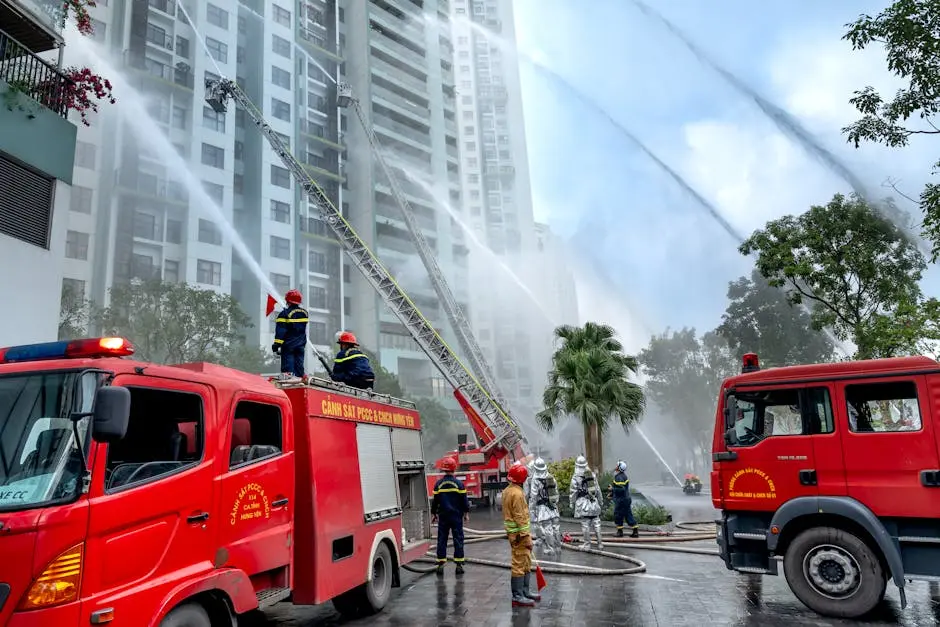Ensuring the safety of your community is a top priority for any Homeowners Association. Fire safety, in particular, is an area that requires attention, preparation, and proactive measures to prevent any incidents. In this blog, we’ll cover essential tips and strategies to maintain fire safety within your HOA, creating a secure environment for everyone.
Understanding the Basics of Fire Safety
Before diving into specific measures, it’s important to understand the basics of fire safety. This includes knowing how fires start, what fuels them, and the different types of fire extinguishers available. Educating yourself and your community on these basics can lay the foundation for effective fire prevention.
Fire safety starts with understanding how a fire ignites. Most fires start from three essential components: heat, fuel, and oxygen. This is known as the fire triangle. Eliminating one of these elements can prevent a fire. Knowing which substances act as fuel in your environment can significantly help reduce fire risks. Common flammable materials include paper, textiles, and certain household chemicals. By identifying and safely storing these items, you can help minimize the potential for a fire to occur.
Creating a Fire Safety Plan
A comprehensive fire safety plan is essential for every HOA. This plan should include evacuation routes, designated assembly points, and procedures for accounting for all residents. In addition, it should outline the roles and responsibilities of community members during an emergency. Regularly reviewing and updating the plan ensures that everyone is prepared.
When crafting a fire safety plan, consider conducting a community-wide fire drill. This drill can prepare residents for a real-life scenario, providing them with the chance to act out various emergency roles. It’s an excellent opportunity to ensure that evacuation routes are clear and accessible for everyone, including those with mobility challenges. Additionally, encouraging participation in these drills helps residents locate their nearest exit in advance, rather than frantically searching during an actual fire.
Incorporating technology into your fire safety plan can enhance its effectiveness. Utilizing apps that provide residents with quick access to the plan and instant emergency alerts can streamline communication during an emergency. Clear communication is pivotal during a crisis, ensuring that everyone is informed and taking the appropriate actions to stay safe.
Routine Maintenance and Inspections
Regular maintenance checks of fire alarms, smoke detectors, and fire extinguishing systems are crucial. These inspections should be scheduled on a regular basis to ensure all equipment is functioning correctly. Additionally, common areas like hallways and exits should be kept clear at all times for easy evacuation.
It’s also important to check that all fire extinguishers are serviced annually and that smoke detectors have fresh batteries. Many fires occur due to lack of routine inspections, which could easily be avoided with a consistent schedule. These maintenance tasks aren’t just background duties but central components of ensuring community safety.
Educating Residents on Fire Safety
Residents play a pivotal role in fire safety. Organizing educational sessions or workshops can help spread awareness and provide practical tips on fire prevention. Topics might include safe cooking practices, proper use of heating equipment, and the importance of not overloading electrical outlets.
Hosting regular fire safety workshops can also encourage residents to develop personal safety plans tailored to their individual needs. This can be particularly beneficial for larger families or individuals who may require extra assistance. Sharing success stories and lessons learned from these workshops can motivate more residents to engage and take fire safety seriously.
Collaborating with Local Fire Departments
Establishing a relationship with your local fire department can enhance your community’s fire safety practices. They can provide valuable insights, conduct drills, and help assess the fire safety needs of your community. Regular collaboration ensures that your safety measures are in line with local regulations.
Consider inviting fire department representatives to community meetings. Their presence not only reinforces the importance of fire safety but also provides an opportunity to address specific concerns or questions residents may have. Often, the fire department can offer demonstrations on how to properly use a fire extinguisher, which can prove invaluable in the event of an actual fire.
Keeping informed on regional fire safety updates and news through the fire department can help your HOA stay ahead of potential threats. Many fire departments also provide comprehensive resources and support for fire prevention and safety education, making them an indispensable partner in maintaining community safety.
Commit to Community Safety
Fire safety in your HOA is not just a responsibility, but a commitment to the well-being of every resident. By implementing these tips and fostering a culture of safety, your community can enjoy peace of mind knowing that you are well-prepared for any fire-related emergencies. Remember, proactive measures today can prevent disasters tomorrow. To learn more about how we can assist you in maintaining a safe community, visit our homepage.





